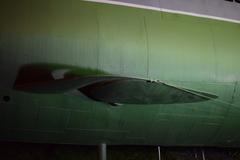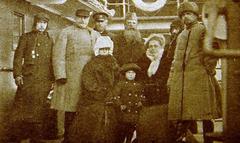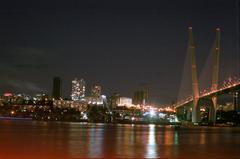
Vladivostok Fortress: Visiting Hours, Tickets, and Historical Sites Guide
Date: 04/07/2025
Introduction
Vladivostok Fortress rises above the scenic Golden Horn Bay, embodying Russia’s enduring military strength and strategic foresight in the Far East. Constructed in the late 19th and early 20th centuries, this vast network of coastal batteries, forts, and subterranean tunnels was designed to defend Russia’s Pacific coastline from emerging naval threats. Today, the fortress is a living museum—offering an immersive experience through its detailed exhibits, panoramic city views, and dynamic cultural programming. For travelers, historians, and military architecture enthusiasts, Vladivostok Fortress is an essential destination that reflects both the city’s storied past and vibrant present (explorecity.life, visit-primorye.ru, vladivostok.travel).
Table of Contents
- Discover Vladivostok Fortress: Visiting Hours, Tickets, and Historical Overview
- Historical Overview
- Architectural and Cultural Significance
- Frequently Asked Questions (FAQ)
- Plan Your Visit
- Vladivostok Fortress: Visiting Guide and Historical Significance
- Arrival and Orientation
- On-Site Experience
- Visitor Amenities and Accessibility
- Seasonal Considerations
- Cultural and Educational Insights
- Practical Tips for Visitors
- Insider Insights
- Vladivostok Fortress: Visiting Hours, Tickets, and Historical Insights
- Summary of Key Points
- References
Discover Vladivostok Fortress: Visiting Hours, Tickets, and Historical Overview
Visiting Hours and Tickets
- Open daily: 10:00 AM – 6:00 PM (last entry at 5:30 PM)
- Ticket prices: ~300–500 RUB for adults; discounts for students, seniors, and children. Tickets are available at the museum entrance (Bezymyannaya Battery) and online via official tourism sites.
- Guided tours: Advance booking recommended, especially during peak seasons.
Guided Tours and Visitor Experience
Guided tours reveal the fortress’s evolution from its 19th-century inception through the Soviet era. Thematic tours—such as night walks and photography sessions—are periodically available. Inside, museum exhibits explore regional military history, while underground casemates and artillery emplacements evoke the fortress’s original function.
Accessibility and Facilities
Key exhibition halls are equipped with ramps and accessible restrooms. However, many tunnels and older structures include stairs and uneven pathways. Contact the museum in advance for detailed accessibility arrangements.
Nearby Attractions
Enhance your visit by exploring the Vladivostok Naval Museum, Russky Island’s Voroshilov Battery, and Eagle’s Nest Hill for panoramic city and bay views. Numerous local cafes and souvenir shops surround the fortress.
Historical Overview
Early Foundations and Strategic Importance
Established in 1860, Vladivostok Fortress was crucial to securing Russia’s eastern borders and expanding imperial influence across the Pacific (explorecity.life, fortressvl.ru). Its prime location on Golden Horn Bay made it ideal for naval defense.
Official Declaration and Early Construction (1889–1904)
Designated as a 4th-class fortress in 1889, Vladivostok underwent extensive artillery and fortification work. The completion of the Trans-Siberian Railway facilitated labor and materials, and a diverse workforce—including local Chinese and Korean laborers—was employed (military-review.com, vladivostok.com).
Russo-Japanese War and Major Expansion (1904–1918)
After Port Arthur fell during the Russo-Japanese War, major expansion and modernization followed. By World War I, the fortress featured 150 structures, interconnected by roads and electrified systems, and could house up to 80,000 soldiers (uvisitrussia.com, factsanddetails.com).
Post-Revolution and Demilitarization (1918–1930s)
Following the 1917 Revolution, work halted. By 1923, the fortress was demilitarized per agreements with Japan, but some batteries were reactivated in the 1930s during renewed tensions (uvisitrussia.com, vladivostok.travel).
Soviet Era and Modern Legacy
Vladivostok became a closed city during the Soviet era, and the fortress remained a strategic asset. After 1991, the site was designated a federal monument, and a museum was founded at Bezymyannaya Battery in 1996 (explorecity.life, uvisitrussia.com).
Architectural and Cultural Significance
Vladivostok Fortress represents Russian military engineering at its peak, uniquely adapted to the mountainous terrain. Its dual system—older coastal batteries paired with newer citadels—demonstrates evolving defensive strategies. In 1919, The Times of London called it “the best of all coastal fortifications worldwide” (fortressvl.ru, vladivostok.com). The fortress’s construction and legacy have profoundly shaped Vladivostok’s identity as Russia’s “Lord of the East” (explorecity.life).
Frequently Asked Questions (FAQ)
Q: What are the Vladivostok Fortress visiting hours?
A: Daily from 10:00 AM to 6:00 PM (last entry at 5:30 PM).
Q: Where can I buy tickets?
A: On-site at the Bezymyannaya Battery or online via official tourism websites. Discounts are available.
Q: Are guided tours offered?
A: Yes, daily, with special options such as night and photography tours.
Q: Is the fortress accessible for wheelchair users?
A: Main museum areas are accessible; tunnels and older sections may have limited access.
Q: What are nearby attractions?
A: Vladivostok Naval Museum, Voroshilov Battery (Russky Island), Eagle’s Nest Hill.
Plan Your Visit
To plan your visit, check official websites for current hours, ticketing, and special events. Download the Audiala app for exclusive tours and insider insights. Embark on a journey through Russia’s Far Eastern history at Vladivostok Fortress.
Vladivostok Fortress: Visiting Guide and Historical Significance
Strategic Context and Purpose
Designed to defend Russia’s Pacific coast, Vladivostok Fortress was strategically placed to control access to Golden Horn Bay and the Sea of Japan. It is considered one of the most formidable examples of Russian military architecture in the region (touristplaces.guide).
Construction Timeline and Scale
Construction began in 1889 and continued through 1918. While only about two-thirds of the original plan was completed, the fortress remains one of the world’s largest coastal defense complexes, spanning over 200 hectares and comprising approximately 70 distinct structures (koryogroup.com, visit-primorye.ru).
Architectural Features and Innovations
- Dispersed Layout: Not a single structure, but a network of forts, batteries, and underground tunnels.
- Construction Materials: Local stone, brick, and reinforced concrete, often camouflaged in the landscape (visit-primorye.ru).
- Defensive Innovations: Multi-layered defenses, concealed positions, and self-sufficient underground complexes.
Military Role and Historical Impact
Though never tested in direct battle, the fortress’s deterrent effect was significant. Its design was influenced by lessons from the Russo-Japanese War and remained a key Soviet defense asset through much of the 20th century (touristplaces.guide).
Notable Structures
- Fort No. 7: The best-preserved and most accessible section, now a museum (koryogroup.com).
- Russky Island Batteries: Remote, atmospheric sites connected via the Russky Island Bridge (wildtrips.net).
- Command Centers & Tunnels: Some are open to guided tours (cultureactivities.com).
Heritage and Preservation
Now a protected monument, the fortress is managed by the Museum-Reserve of the History of the Far East and serves as a venue for cultural events (visit-primorye.ru).
Arrival and Orientation
Location and Layout
The fortress comprises fortifications, bunkers, and batteries across Vladivostok and its islands, with the main museum centrally located (vladivostok.travel).
Getting There
Arrive via Vladivostok International Airport or the Trans-Siberian Railway. Local transport—buses, trams, taxis—connects the city center to the fortress (Things.in).
On-Site Experience
Visiting Hours and Tickets
Open daily from 10:00 to 18:00 (Trip.com). Guided tours (~3–4 hours) are best booked in advance (Travelspilot.com).
Exploring the Fortress
Tour original fortifications, tunnels, and artillery emplacements. Wear sturdy shoes due to uneven surfaces.
Museum Exhibits
Artifacts include weapons, uniforms, maps, and interactive multimedia displays (vladivostok.travel).
Panoramic Views
Observation decks, like Eagle’s Nest Hill, offer stunning vistas (AdventureBackpack.com).
Visitor Amenities and Accessibility
- Facilities: Restrooms, café, souvenir shop.
- Accessibility: Main areas are accessible, but tunnels and historic structures may be challenging for some.
- Safety: Watch for uneven ground; children should be supervised.
Seasonal Considerations
- Best Times: Late spring and early autumn for mild weather (Things.in).
- Weather: Ranges from -10°C in winter to 30°C in summer; dress appropriately (AdventureBackpack.com).
Cultural and Educational Insights
- Significance: The fortress symbolizes Russian naval power and deterrence (vladivostok.travel).
- Local Engagement: Festivals and art installations foster community pride.
Practical Tips for Visitors
- Advance Booking: Advised for guided tours.
- Duration: Allocate at least 3–4 hours.
- Language: English-speaking guides available by request.
- Photography: Allowed, but flash/tripods may be restricted.
Insider Insights
- Seek out guides for access to lesser-known tunnels and special events.
- Respect site rules and local etiquette.
Vladivostok Fortress: Visiting Hours, Tickets, and Historical Insights
Historical and Cultural Significance
Constructed to protect Russia’s Pacific interests, the fortress features advanced fortifications and reflects the city’s rich multicultural heritage (travelertopia.com, adventurebackpack.com, mexicohistorico.com).
Practical Visitor Information
- Hours: 9:00 AM–6:00 PM daily; extended in summer.
- Tickets: Adults 500 RUB, students/seniors 300 RUB, under 7 free.
- Guided Tours: Led by local historians, regularly available.
- Accessibility: Some sections accessible; inquire for assistance.
- Nearby Attractions: Oceanarium, Russky Island Bridge, waterfront.
Educational and Social Engagement
The fortress hosts museums, educational programs, and cultural events, supporting both learning and local business (travelspilot.com).
Visitor Etiquette
Engage respectfully, learn basic Russian greetings, and support local artisans.
Summary of Key Points About Vladivostok Fortress Visitor Information and Tips
Vladivostok Fortress is a testament to Russia’s strategic vision and architectural ingenuity. As both a historic monument and a vibrant cultural hub, it offers guided tours, accessible hours, and engaging exhibits. Visitors can confidently plan trips with the help of official resources, mobile apps, and on-site staff. Respectful engagement and sustainable tourism are encouraged to preserve this unique legacy (visit-primorye.ru, koryogroup.com, vladivostok.travel).
References Including Official Websites and Credible Sources
- explorecity.life
- fortressvl.ru
- military-review.com
- vladivostok.com
- uvisitrussia.com
- touristplaces.guide
- koryogroup.com
- visit-primorye.ru
- vladivostok.travel
- Trip.com
- Travelspilot.com
- Things.in
- AdventureBackpack.com
- wildtrips.net
- cultureactivities.com
- travelertopia.com
- mexicohistorico.com




